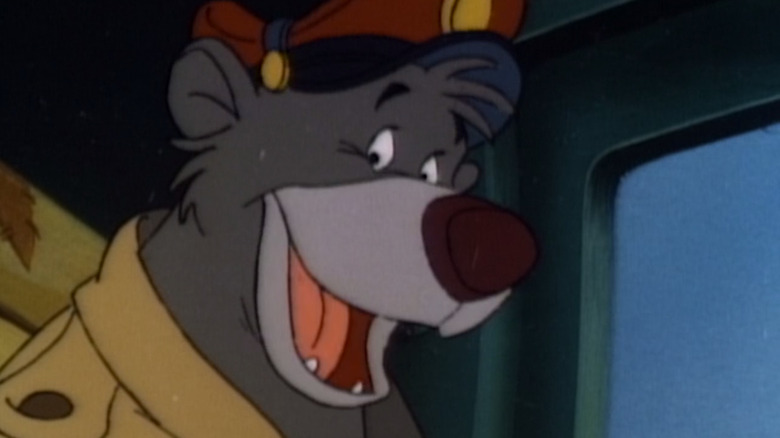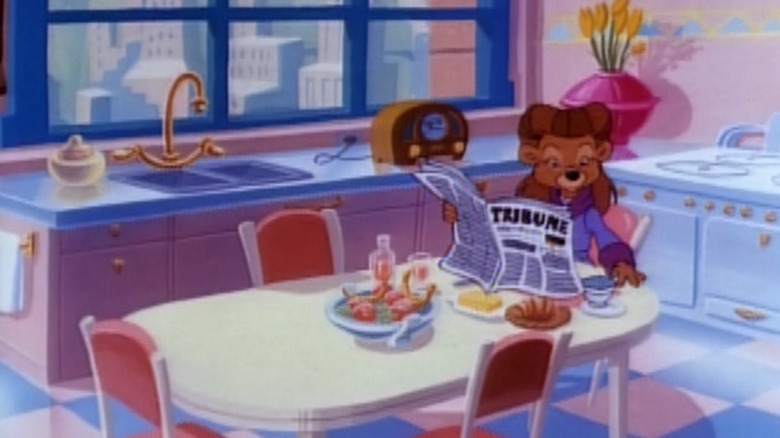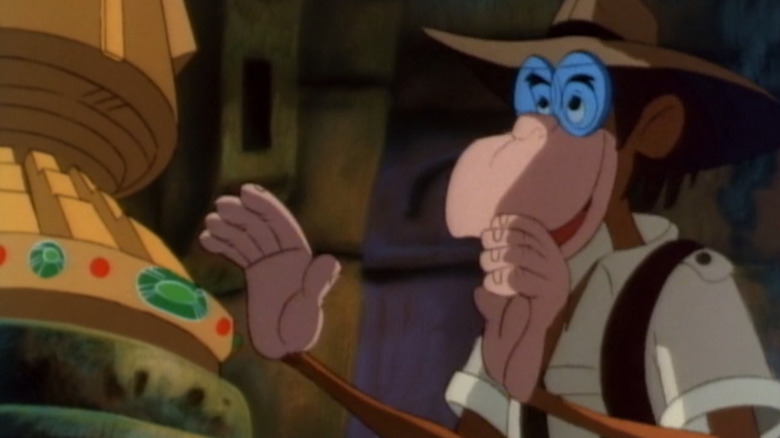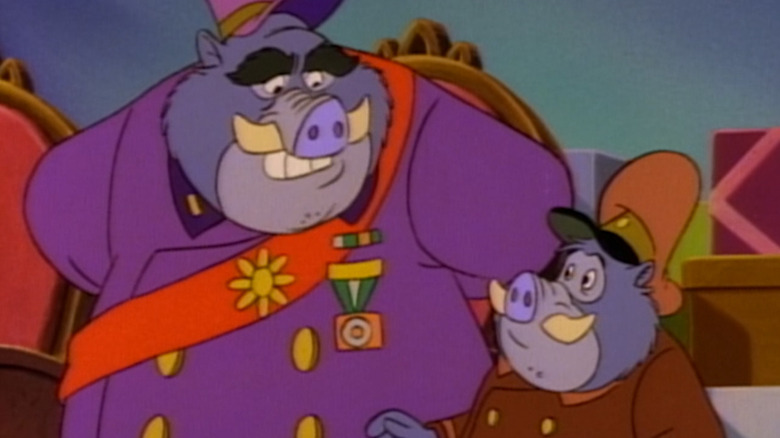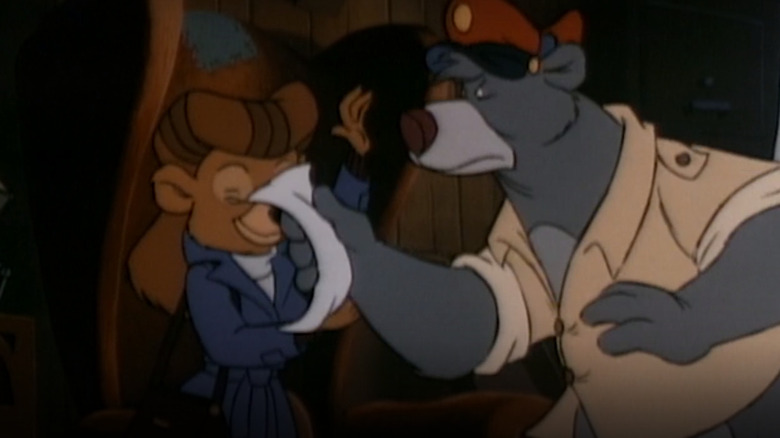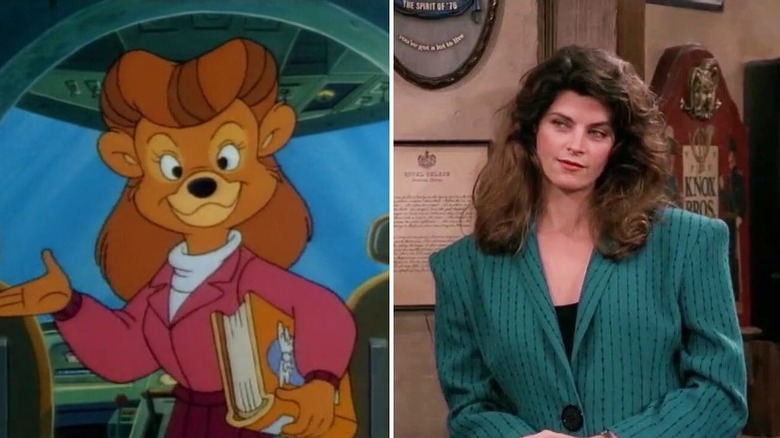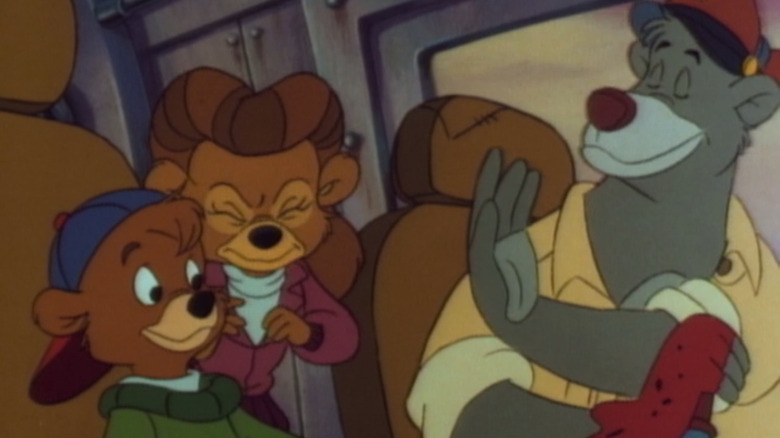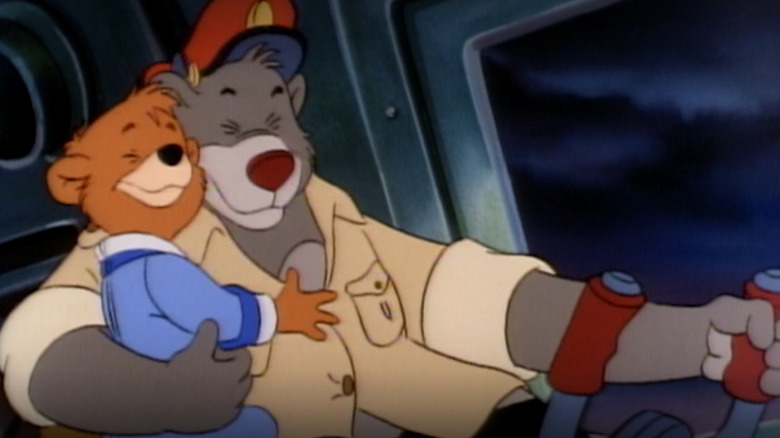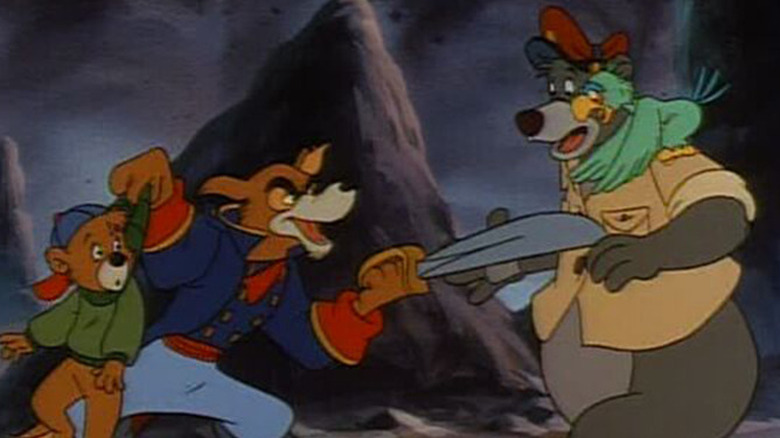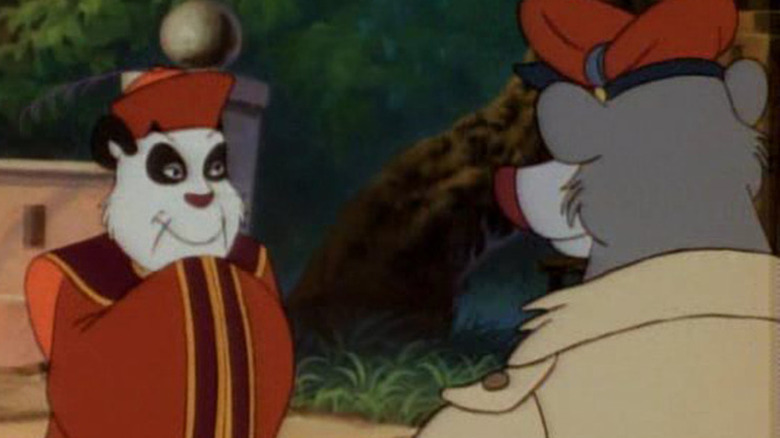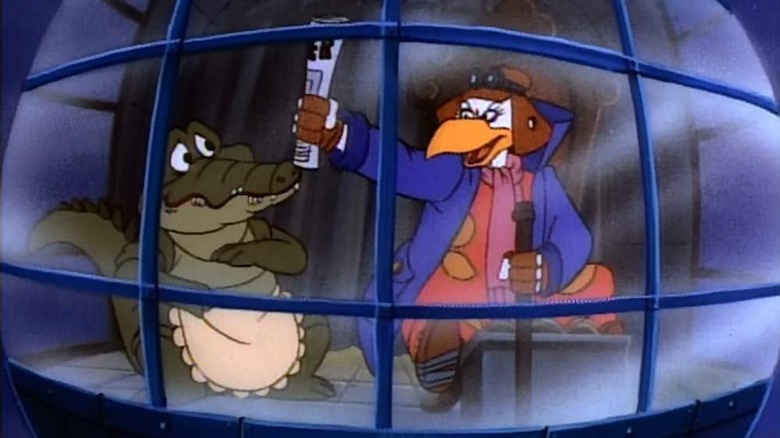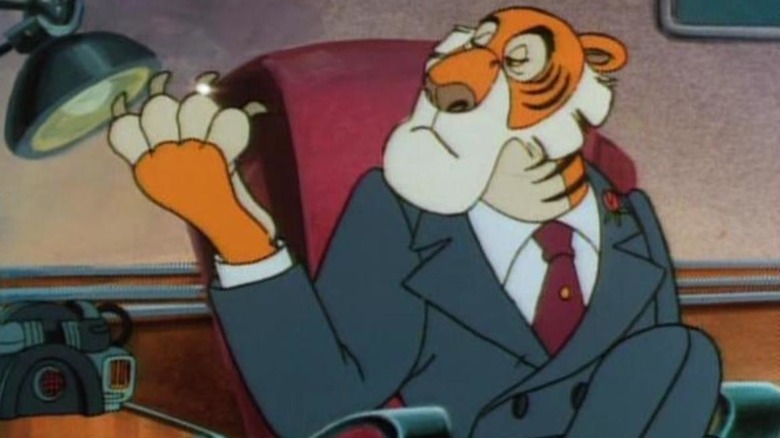Things In TaleSpin Only Adults Notice
What do you get when you take characters from "The Jungle Book," throw them between two World Wars, set them off on globe-trotting adventures, and — here's the kicker — give them a job in the air cargo business? "TaleSpin," of course — one of the most uniquely charming cartoons ever to come out of Disney.
"TaleSpin" takes Baloo, Louie, and Shere Khan from "The Jungle Book," replaces Mowgli with Kit Cloudkicker (because humans have no place in this reality), and builds out an entire world of new characters. There are swashbuckling air pirates led by Don Karnage, the ineffectual duo of Colonel Spigot and Sgt. Dunder, along with Baloo's new boss, Rebecca Cunningham.
The show only got a single season of 65 episodes, but fans of the series growing up still look back fondly on it today. However, those who do go back and watch it today might find an entirely different experience from when they were kids. It's still just as enjoyable, but the slapstick humor and wild adventures take on an entirely different dimension when viewed through an adult's eyes.
From puns and obscure jokes to sophisticated concepts and real-world allegories, "TaleSpin" has a little something for everyone. Finding these deeper connections, whether humorous or heartfelt, only make the show better, so to help you strengthen some bonds to your childhood, here are things about "TaleSpin" that only adults would notice.
The show is set in the 1930s
Of all the Disney Afternoon shows, "TaleSpin" had one of the most unique concepts. Characters from "The Jungle Book" were updated for modern audiences — but not necessarily to modern times. Unlike "The Jungle Book," "TaleSpin" most definitely does not take place in the 19th century, but it's not entirely clear when it is supposed to exist other than the early 20th century. Its time period remains unclear until the second-to-last episode.
In "Bygones," Baloo meets a famed fighter pilot named Rick Sky, who'd been missing for 20 years. It turns out he'd been trapped in ice, just like Captain America, but the critical moment comes when they mention that the "Great War" ended 20 years earlier. The Great War, of course, is what folks called World War 1 before there was a World War 2, though it's kind of tragic that it would still exist in the world of "TaleSpin." Even Rick's plane, a "Stropwith Dromedary," is a pretty clear parody of Britain's famed Sopwith Camels. Provided the "TaleSpin" war ended the same year — 1918 — as in real life, the episode would occur in (or around, if it wasn't exactly 20 years) 1938.
While kids may not think much about when the series takes place, it makes sense. The planes are all propeller-powered, and instead of televisions, radios provide entertainment. Even Rebecca's hairstyle is an updo reminiscent of the '30s and '40s.
TaleSpin owes a lot to Indiana Jones
When it comes to cartoons, kids don't spend a lot of time thinking about their influences. For adults, though, sometimes they're hard to miss, especially when they're as inundated with references as "TaleSpin" is to the "Indiana Jones" franchise. For a company that's supposed to be hauling cargo around, Baloo and friends sure do spend a lot of time finding lost civilizations and mythical artifacts. Tinabula, for instance, in "For Whom the Bell Klangs" was, like Tanis in "Raiders of the Lost Ark," buried beneath the desert. And the Idol of Doom in "Destiny Rides Again" sounds a lot like Indy's second film outing.
Then there's "The Idol Rich," where Baloo and Kit compete with an enemy nation — the Thembrians — to get their hands on a long-lost artifact. The ties get even more explicit with episodes like "Waiders of the Wost Tweasure," which, besides the title, has a scene with Kit and Baloo fleeing a giant boulder. Also, don't forget Professor O'Bowens, the chimpanzee archeologist with a wide-brimmed hat, satchel, and whip from "A Baloo Switcheroo" and "Destiny Rides Again."
Granted, both "TaleSpin" and the "Indiana Jones" franchise owe a lot to action-adventure serials of the 1930s, so it makes sense that they contain similar elements. However, there's still a lot of call-backs and parodies tying the two together long before Disney bought LucasFilm and brought "TaleSpin" and Indiana Jones together in the same entertainment family.
The Thembrians are Stalinist Soviets
First introduced as incompetent villains competing for a lost artifact in "The Idol Rich," the Thembrians are slowly built out over the series. Even for children, it's pretty apparent that the Thembrians are supposed to be Russian. From the warthogs' accents and snow-covered homeland to their furry coats and ushankas on their heads, everything about them screams "Russia." What's less obvious, though, is that they're actually Stalinist Soviets.
Their nation is a bureaucratic nightmare where courts hand out punishments like 1,000 years in prison for playing in the snow. While much of Thembria is ridiculed, the nation is run by the cruel High Marshall, who's reminiscent of Joseph Stalin. His introduction in "A Spy in the Ointment" is darkly humorous, with an emphasis on the dark.
At one point, the High Marshall runs across Colonel Spigot and asks his aide if he knows the warthog. His aide explains that Spigot is the head of his air force, to which the High Marshall responds, "Didn't I have him shot?" His aide informs him, "Not yet." Before leaving, the High Marshall threatens to shoot Spigot if he fails.
The real Stalin, of course, condemned hundreds of thousands of people to death, even those in his government and military. No one was ever safe as he consolidated power and eliminated anyone who might be a threat or displeased him. It's clear that the Thembrians aren't just the Soviets, but the Soviets at the height of Stalin's cruel dictatorship.
The show dealt with financial topics that aren't exactly tailored to kids
Monetary responsibility is something that kids should probably be taught sooner rather than later. Teaching them to save up their allowance, however, is a bit different than teaching them not to default on a loan. However, regardless of whether or not young viewers understood it, that's exactly how "TaleSpin" starts.
First off, it's worth asking how Baloo ever got a business to begin with. Before Rebecca comes along, he doesn't seem fond of working or paying bills. Or loans. In fact, that's how she swoops in and takes the business from Baloo. He misses too many mortgage payments, so the bank collects their property and sells it to Rebecca. She takes over in the second episode and renames the business "Higher for Hire." She brings on Baloo as a pilot because she can't run a cargo business without one, even claiming his plane, the Sea Duck.
Such financial dealings aren't exactly kid fodder, but they did make the whole premise work. As co-showrunner Jymn Magon told fans on Animation Source, "the show was intended for kid after school audiences, but I don't think we actively tried to target any one group. If the little 'uns enjoy the slapstick and the action, then they don't have to get the older concepts ... 'til they get older."
Rebecca Cunningham is modeled after Rebecca Howe from Cheers
This is one reference that becomes stunningly obvious once "TaleSpin" fans hit a certain age because almost everything about Rebecca Cunningham is inspired from the "Cheers" Rebecca. First off, they're both successful businesswomen who take over our heroes' companies and keep them on as employees. On "Cheers," Rebecca is put in place to manage the bar after Sam sells it to a corporation. On "TaleSpin," Rebecca buys it out from under Baloo's nose.
Then there's the will-they, won't-they tension that kids might not pick up on between the leads. "TaleSpin," though, is a family cartoon, so while Sam and Rebecca end up try sleeping together and decide they aren't for each other, Baloo and Rebecca never get that far. They do, however, have the same kind of love/hate tension and even go on the occasional "friend" date like in "A Star is Torn."
The Rebecca in "TaleSpin," however, doesn't quite end up as much of a neurotic mess as the Rebecca from "Cheers." The latter was still unraveling from her straight-laced origins when "TaleSpin" was made. One of the show's co-runners, Jymn Magon, confirmed the connection while answering questions on Animation Source. "No revelation here," he wrote, "Baloo and Becky were fashioned after Sam and Rebecca from the (then) popular sitcom 'Cheers.' ... It was a good dynamic — plus we had the added bonus of the two of them watching over Kit."
Kit Cloudkicker is one of the most mature characters on the show
Yes, Rebecca is the adult of the show, but at only 12, Kit is amazingly mature. He's respectful of Rebecca both as his boss and mother figure, but he's not nearly as caught up on appearances or desperate to fit into high society as she is. He even convinces her to look past Baloo's rough edges when she can't find a date to the Businessman's Ball and needs someone to help her mingle with the movers and shakers in "My Fair Baloo."
Beyond that, when it comes to Baloo, Kit's the responsible one. He's the navigator on a metaphorical as well as literal level, trying to keep the older bear on track at work. Few episodes showcase this better than "Double or Nothing," when Kit even acts as a parent, consoling Baloo after his favorite record breaks. He then reluctantly goes along with Baloo's scheme to take Kit's hard-earned money and double it the easy way. Baloo wants cash to buy a new record, and Kit's got just what he needs.
Kit's beside himself the entire episode, well aware that his excited partner is full of crazy schemes that never work out. In the end, they do make $10,000 only to lose all but $100 of it — double Kit's life savings, just as Baloo promised. Kit, though, surprises him and uses it to buy Baloo's record. It's a selfless, grown-up act as only Kit could manage.
Baloo and Kit's relationship is surprisingly deep
At first glance, Kit and Baloo's relationship is simple. Baloo's the oafish, immature father figure who'd rather be a friend than a parent, and Kit, more often than not, has to step up and be the adult. However, things go a little deeper than that. Ultimately, Kit is still a kid who has grown up too fast when he is orphaned and taken in by air pirates. Kit may be more mature, but Baloo's still the loving parent.
Kit endearingly calls Baloo "Papa Bear," and Baloo is protective of his "little britches" and willing to fight to keep him safe. In the episode "Stormy Weather," Kit's lured away with promises of circus stardom by a conman named Daring Dan. Baloo's happy to let Kit have his fun, cloud surf (though how is that even remotely safe?) and be silly, but he understands where the limits are. Dan's stunts put Kit in real danger.
When Baloo tries to put his foot down and forbid Kit from joining the circus, the young cub does what so many kids dealing with abandonment have done — yells that Baloo isn't his father and cries himself to sleep. Afterward, he runs off to join the circus — and it does almost cost him his life. When Baloo saves him, Kit's hug as he thanks his "Papa Bear" is one of the most touching moments of the series and drives at how deep their father/son relationship really is.
Baloo's a Monty Python fan
That's right, there's a Monty Python reference in "TaleSpin." In a blink-and-you'll-miss-it moment only true fans would even notice, Baloo makes clear that he, too, enjoys the "Flying Circus." Yes, this is slightly odd since the "TaleSpin" takes place over 30 years before the funny Brits began their show, but just go with it. The moment in question comes during the episode "Polly Wants a Treasure," when Baloo and Kit find a parrot who can lead them to buried pirate treasure.
The parrot, Ignatz, immediately takes a liking to Kit but hates Baloo. The feeling's mutual. Baloo calls him a new insult every time they interact, everything from "flying ferret" to "the losing side of a pillow fight." When the pirate Dumptruck disguises himself as a bird lover and tries to buy Ignatz, though, Baloo has no idea what type of parrot he is and refers to him as a "rare Norwegian Blue." It's humorous for those in the know, but it also seems like it might be a vague threat.
Norwegian Blues are rare. They're so rare, in fact, there's only ever been one other bird in the world — and that was in Monty Python's "Dead Parrot Sketch." When John Cleese tries to return his dead parrot to shopkeeper Michael Palin, he refers to it as a completely made-up "Norwegian Blue." The sketch is legendarily hilarious, but still, the parrot's dead — something Baloo probably wouldn't have minded for the irritating Ignatz.
Last Horizons is a problematic episode
Like with the Thembrians and the Soviets, the world of "TaleSpin" is full of analogs to real-world peoples and cultures. Some are pretty specific — Bavaria is a stand-in for Germany — while others are painted in broader strokes like, Macademia being a generic Middle Eastern nation — which is kind of problematic in itself.
Then there's the legendary Panda-La, named after the fictional Shangri-La created by British author James Hilton. The episode even swipes its title from the book's name, "Lost Horizon." At first glance, Panda-La seems to be in China, or perhaps, like Shangri-la, Tibet. Panda's are native to the area, so of course, they'd be Chinese. However, Panda-La is ruled by an emperor, and there were no emperors in 1930s China, Tibet, or Shangri-La. Japan had one, though.
In the episode, Baloo thinks he's discovered an idyllic paradise. The pandas lull him into a false sense of security, only to reveal their treachery. Their buildings can fly and the whole city moves around, conquering others. Thanks to Baloo, Cape Suzette is next. The Panda-Las launch a sneak attack and are nearly successful until Baloo chases them off. It's hard to avoid the Japanese and Pearl Harbor parallels here. It's also hard to avoid the fact that "TaleSpin" seems to have lumped the Chinese and Japanese together as Asian and presented them as warmongering conquerors. Disney even seems to agree, as it's one of two episodes not on Disney+.
TaleSpin is loaded with sophisticated puns
If there's one thing that's hard to miss about "TaleSpin," it's the puns. The series is awash in them, from places to characters. A good chunk of the action even takes place in a pun: Cape Suzette. If the name doesn't instantly make you crave dessert (crêpe suzette, get it?), you've got more willpower than most. Then there are characters like the lost pirate captain, Juan Toomany, in "Polly Wants a Treasure," or the fabulously wealthy Prince Neverhas Bin Broak in "I Only Have Ice For You." These are all pretty easy to understand, though, no matter your age. However, other puns reference things children would never get.
Most of the more sophisticated wordplay comes in the episode titles, which reference all sorts of cultural touchstones. There are all kinds of literary references, episodes with names like "The Sound and the Furry" after William Faulkner's "The Sound and the Fury," or "For Whom the Bell Klangs," after Ernest Hemingway's "For Whom the Bell Tolls."
Then there are the classic films referenced like "Citizen Kane" with "Citizen Khan." The Clint Eastwood western "For a Few Dollars More" becomes "For a Fuel Dollars More," and even Ronald Reagan's invoked with "Mach One for the Gipper." Whether or not their target audience would ever understand, the writers clearly had fun with "TaleSpin."
Shere Khan is the epitome of amoral capitalism
In "The Jungle Book," Shere Khan is the undeniable villain, stalking Mowgli and savaging Baloo. The rest of the jungle fears him, but he only fears fire and guns. In "TaleSpin," though, Shere Khan is far more nuanced. Sometimes Shere Khan helps out the heroes, like when he rewards Baloo (only to come to regret it) for saving his life in "Save the Tiger." Other times, he works with the villains, pulling schemes like using the air pirates to create an oil shortage in "On a Wing and a Bear" to drive up his prices.
Fans who grew up with the series still tend to think of him in the same stuck-in-the-middle way as they did as kids, they just have a new word for it now: "Neutral." Except, Khan isn't really neutral. It's not like he tries to stay in the middle or keep bad guys and the good guys balanced. He just doesn't care. In the end, he's a capitalist in its purest form. Even Baloo's reward is transactional. The bear performed a service, so he received payment — until it became fiscally untenable.
He works with villains and heroes because he's willing to do whatever he has to for the bottom line. He's an amoral businessman. As co-showrunner Jymn Magon put it on Animation Source, "If he can profit from a situation, he will. If he can't, he will instantly walk away."
